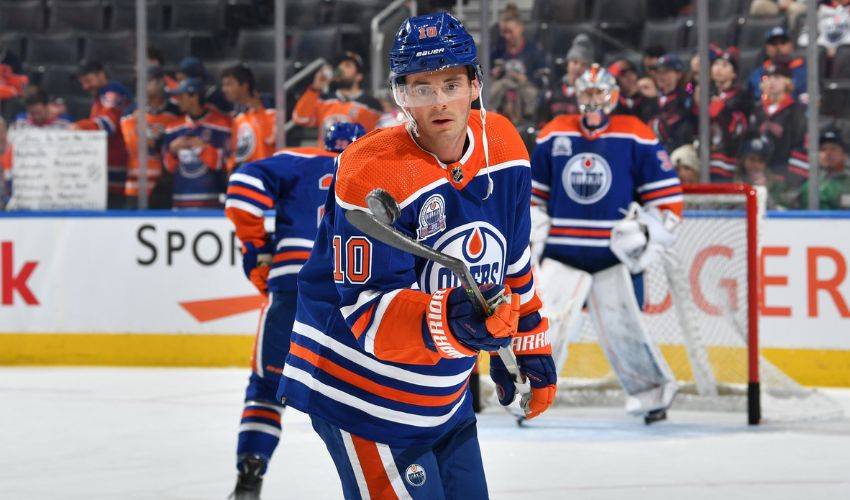Ryan reflects on scenic route taken to NHL
From the University of Alberta to Europe and back to Alberta – Edmonton Oilers forward Derek Ryan made his NHL debut at 29 years old.

Feature photo: Getty Images
Derek Ryan’s route to the NHL was anything but traditional, but a winning attitude and a world of hockey experience made him a perfect fit to make his debut at 29 years old.
Few NHL players have skated along a similar path to Ryan’s, one that has taken him around the globe.
Born in Spokane, Washington, Ryan played for his hometown Spokane Chiefs of the Western Hockey League club before enrolling in the University of Alberta, where he played four seasons with the Golden Bears, earning USPORTS First Team All-Canadian honours in his final season and graduating with a degree in human physiology.
He then turned his attention to Europe.
“You want to get to the NHL before the age of 29, but for me, the steps that I had to take were monumental in driving the game that I have now,” said the 37-year-old, who is playing in his eighth full NHL season.
Spokane, Alberta, Hungary, Austria, Sweden, Charlotte, Carolina, Calgary and Edmonton – Ryan’s hockey road map has covered thousands of kilometres, multiple leagues.
Each stop – junior, collegiate, the minors, or otherwise – presented a welcome opportunity to hone and heighten his skill set.
“Every step of the way, I picked up new strengths and attributes. In Austria, it was such a high-paced, offensive-minded game. The games seemed to be 5-4, 6-5, a lot of two-on-ones, three-on-twos – a ton of scoring chances. That helped me with offensive skills, playmaking and finishing off chances.”
After three seasons in Austria, Ryan moved on to the Swedish Elite League, where he played one campaign with Orebro HK in 2013-14. Over 55 games, he recorded 60 points – 15 of them goals.
“It is literally the exact opposite of the Austrian League. Playing a 1-0 game in Sweden is the best game ever – the fans love that. It’s hard to score there. They have big, strong defencemen and big, mobile goalies, who are hard to get one by.
“The game I played in Austria doesn’t translate there, so I had to adapt my game – checking, the importance of playing without the puck – which also helped me out immensely.”
As did Ryan’s time in the American Hockey League.
Between 2015 and 2017, he skated in 79 games with the Charlotte Checkers, the AHL affiliate of the Carolina Hurricanes, who Ryan had signed a free agent contract with on June 15, 2015.
“Coming back to North America and playing in the AHL, I was playing young, talented guys. I had to adapt my game again to the smaller ice surface.
“Each layer was added as I developed skills at each step. That helped me with my abilities as I went along.”
On March 1, 2016, at the age of 29, Ryan played in his first NHL game and scored his first NHL goal.
Three years after signing with Carolina, Ryan signed as a free agent with the Calgary Flames, where he would play 192 regular-season games and 15 post-season contests.
Since signing with the Oilers as a free agent July 28, 2021, Ryan has proven himself to be a valuable asset to the team. He scored his first NHL hat trick with Edmonton on Feb. 26, 2022, and was the club’s Masterson Trophy nominee in 2023.
His strength in the faceoff circle and abilities as a versatile depth forward have made him a valued teammate.
“I don’t really know,” Ryan said of how he developed his faceoff skill. “It is something that I have worked on before I got to the NHL, and take pride in.
“I have been in the league long enough to know who I am going up against. I take time before each game to go on the iPad. Our coaches are great – they give us plenty of clips of the guys we are going up against. It helps a lot, but at the end of the day, it’s a big chess match out there. You are trying different things and so are they.”
With a career faceoff winning percentage of 55%, Ryan’s body of work in the circle is perhaps the best example of who he is as a player.
“It’s kind of a microcosm of my game. I’m a thinker and I think my way around the ice. With faceoffs, you have to grow, adapt and think your way through what they are doing.”
As for what he perceives to be a successful game, on an individual level, lighting the lamp or picking up an assist aren’t the barometers.
“One of the markers I have is where I am spending my shifts. As a faceoff guy, I’m usually starting a lot of my shifts in the defensive zone and taking those draws on my backhand. If I can start there and transition to offensive zone time – creating chances and momentum – then that is a success. If I am doing that a majority of the time, I find that to be an indicator of success.
“Penalty kill time, winning those faceoffs becomes even more important. I don’t think it’s one big thing that defines a good game for me, but it’s the small things that add up. It doesn’t have to be a goal or assist – it could be key defensive plays when the game is on the line. Winning a draw, blocking a shot, or making a good play down low – those are the types of things that translate into what I would see as a good game.”
Those contributions will take on more importance come playoff time.
Ryan won’t be tinkering with his approach when the puck drops on the post-season.
“I look at keeping my game the same, whether it’s regular season or playoffs. But with the playoffs, the pace quickens, the emotion heightens, and the stakes are higher. Every detail and the margin of error is crucial.
“Playoffs are a whole other animal in that every shift matters and that is how I approach every game. I’m not getting big minutes, so when I am on the ice, I want to make the most of the time out there.”
Which is what Ryan has done throughout an NHL career that, at various points in time, felt like a longshot at best.
Does he think the sum of those experiences helped him become a full-time NHL player?
“I have looked back on my journey a lot, talked about it a lot, and answered a lot of questions about it. I guess the hard work and not giving up did pay off in the end.”

